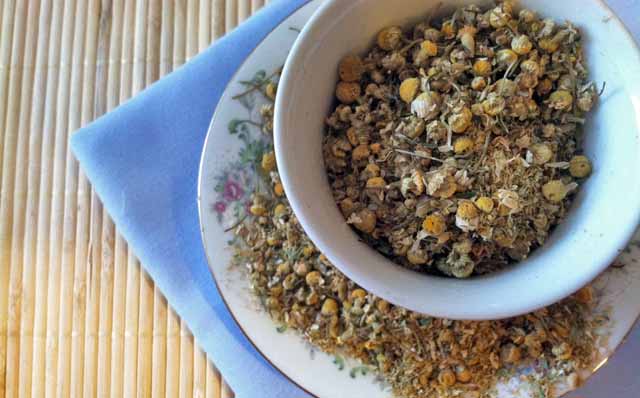Chamomile is one of the most well-known herbs, and one I’m never without, especially with small children.
It is widely available in tea form, but can also be made into capsules, tinctures, or used in cosmetic applications.
Chamomile flowers are mildly sedative, making them wonderful for improving sleep quality and relaxation. I use chamomile in place of Tylenol for teething or colicky babies, and on my own stomach after giving birth to help ease the after pains.
I’ve also heard of natural doctors using a strong chamomile tincture as a nervine to reduce cravings in patients who are stopping smoking or drug use. It is a good herbal source of Magnesium, which is one of the top supplements I recommend.
Ways to Use Chamomile
- As an herbal tea before bedtime to help improve relaxation and sleep
- As a tincture (internally or externally) for muscle pain or for teething children (on the gums)
- As a tincture for children who have trouble sleeping or who are emotionally upset
- As a strong brewed tea in the hair to naturally lighten blonde tones
- To help relax during emotional or physical distress (I use the tincture internally during labor to help ease contractions and help me relax)
- Internally and externally for headache relief
- As a tincture to help calm hyper children
- For pink eye: Pour a small amount of boiling water over a chamomile tea bag and soak on the eye for about 15 minutes a few times a day (wait until its cool) OR make a strong tea with it and use a soaked cotton ball to wipe the eye every hour throughout the day and infection should be gone within 24-36 hours. Can also sleep with a cotton ball “patch” on the eye to help remove the infection.
Where to Get Chamomile
- As with most herbs, I buy in bulk from Starwest Botanicals as this is the cheapest way to order and I am confident in the quality of their herbs.
- I highly recommend making a chamomile tincture (instructions here) as the flowers can easily lose their natural oils, which make them effective. You can also buy a pre-made tincture if you’d prefer not to make your own.
- There are also capsules available, though I would not suggest a concentrated dose like this for children, and this would be more effective when stopping a tobacco or drug addiction as overseen by a natural doctor.
- You can also, of course, get Chamomile tea bags, which is the most widely available form of chamomile.
Notes: Chamomile is generally considered a safe herb for anyone, including during pregnancy, but in very rare cases it can cause an allergic reaction in those with ragweed allergies, so use caution if you have these types of allergies.
Do you use chamomile? What is your favorite use? Share below!


Leave a Reply